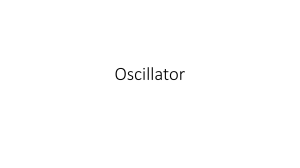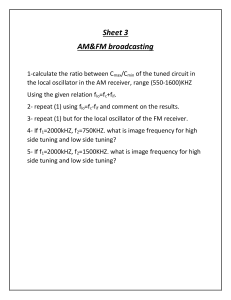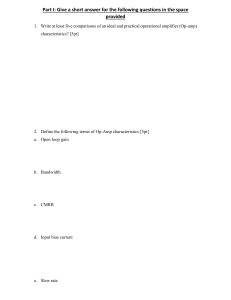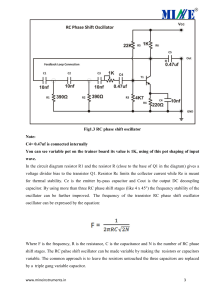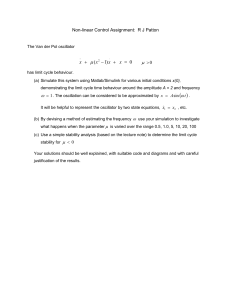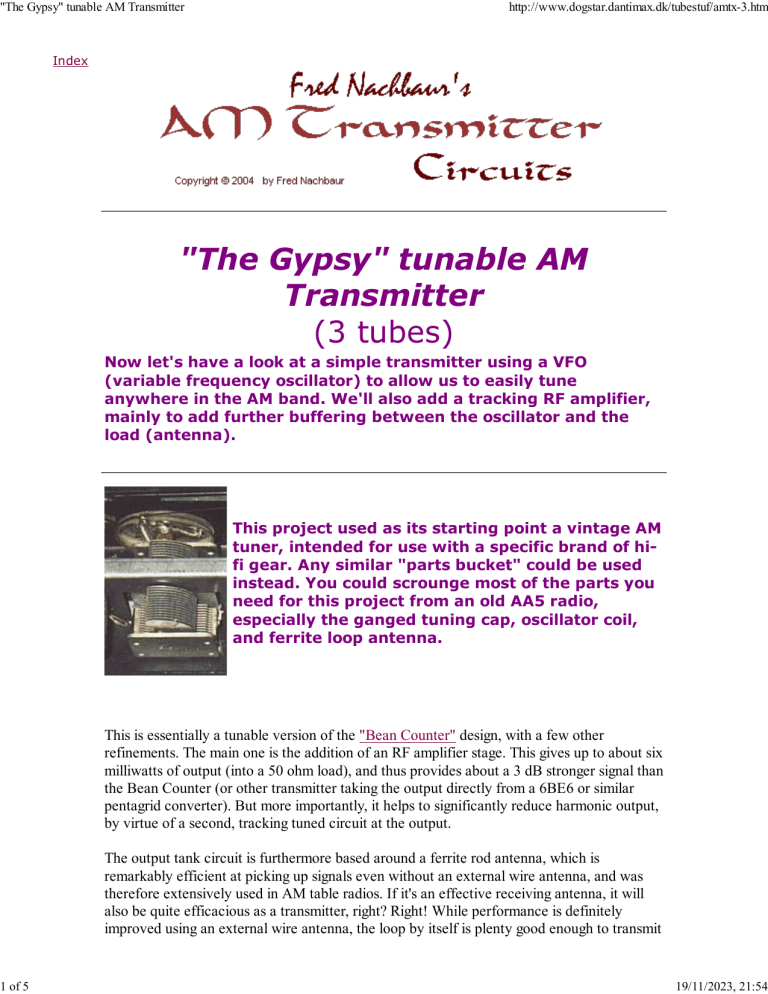
"The Gypsy" tunable AM Transmitter 1 of 5 http://www.dogstar.dantimax.dk/tubestuf/amtx-3.htm Index "The Gypsy" tunable AM Transmitter (3 tubes) Now let's have a look at a simple transmitter using a VFO (variable frequency oscillator) to allow us to easily tune anywhere in the AM band. We'll also add a tracking RF amplifier, mainly to add further buffering between the oscillator and the load (antenna). This project used as its starting point a vintage AM tuner, intended for use with a specific brand of hifi gear. Any similar "parts bucket" could be used instead. You could scrounge most of the parts you need for this project from an old AA5 radio, especially the ganged tuning cap, oscillator coil, and ferrite loop antenna. This is essentially a tunable version of the "Bean Counter" design, with a few other refinements. The main one is the addition of an RF amplifier stage. This gives up to about six milliwatts of output (into a 50 ohm load), and thus provides about a 3 dB stronger signal than the Bean Counter (or other transmitter taking the output directly from a 6BE6 or similar pentagrid converter). But more importantly, it helps to significantly reduce harmonic output, by virtue of a second, tracking tuned circuit at the output. The output tank circuit is furthermore based around a ferrite rod antenna, which is remarkably efficient at picking up signals even without an external wire antenna, and was therefore extensively used in AM table radios. If it's an effective receiving antenna, it will also be quite efficacious as a transmitter, right? Right! While performance is definitely improved using an external wire antenna, the loop by itself is plenty good enough to transmit 19/11/2023, 21:54 "The Gypsy" tunable AM Transmitter 2 of 5 http://www.dogstar.dantimax.dk/tubestuf/amtx-3.htm nicely to radios in adjacent rooms in your house. The power supply is slightly different from the other designs on this site, in that there are individually decoupled power supply filter sections. The rationale behind this was to provide good decoupling between the three tubes involved, whilst keeping the voltages reasonably high. Note that all the screen grids share the same filter section. This allows all three screen grid voltages to be adjusted at the same time, if need be, simply by changing resistor R18. The tuning capacitor C1 is an ordinary two-gang tuning capacitor, as is used on AA5 and similar AM radios. The smaller section typically has a maximum capacitance of about 300 pF, and is used as the tuning capacitor for the oscillator tank. The larger section is typically about 400 pF, and forms the tuning capacitor for the antenna tank. Note that we're still using essentially the same idea -- the original AM receiver oscillator coil is used in conjunction with the smaller capacitor section, as before, to give our oscillator, and the larger section is used together with the loop antenna to provide our RF amplifier output tuning. However, there is a problem. In a receiver, the oscillator tank actually operates at a frequency 455 kHz. higher than the received signal. In our circuit, we of course want both tuned circuits to track at the same time. We can get around that quite readily, provided that the original tapped oscillator coil is slug-tuned. 19/11/2023, 21:54 "The Gypsy" tunable AM Transmitter 3 of 5 http://www.dogstar.dantimax.dk/tubestuf/amtx-3.htm After building the transmitter, run it without the RF amplifier tube. Position an ordinary AM radio near the transmitter, and turn the tuning dial all the way to the low end. By adjusting the slug in the oscillator coil, adjust it so that the output frequency is as low as possible. If you can't get it all the way down to 550 kHz, you'll have to remove the oscillator coil, and add some more turns of wire to the high side of the coil (be sure you wind it in the same direction as the existing winding). In the particular coil I had, adding 15 turns gave enough inductance to let me adjust the oscillator down to 550 kHz with the capacitor plates fully meshed. You might be tempted to wind an air-core coil from scratch. Unfortunately, this doesn't usually pan out very well. The reason is that such a coil has too much distributed capacitance, and won't let you tune all the way to the high end of the AM band (1700 kHz). You're pretty much stuck with having to use a permeability-tuned (slug tuned) coil if you want to cover the full BCB frequency range. Once you've got the oscillator tuning down to 550 kHz, set the high end of the band. This is done by adjusting the trimmer capacitor on the side of the tuning cap. Then go back down to 550 kHz, and re-adjust the oscillator coil. Adjust the trim cap at the high end, and the coil at the low end. Do this a few times, the adjustments will soon converge. (Experienced radio tuners develop a knack for over-shooting the adjustment to make the procedure converge more quickly.) Finally, insert the RF amplifier, and fire it up. Using an oscilloscope to monitor the output, adjust the trim cap on the larger section of the tuning cap for maximum output at the high end of the band. Unlike the oscillator section, there is no provision for tuning the bottom end, and we have to rely on the original accuracy of the rod antenna for a reasonable tune at the low end. You'll notice that the tracking won't be perfect; in other words, the dial calibration around the middle of the band will be off a little. Besides, there will be some variance in output level as you tune across the band. This isn't serious by any means, and the tracking is certainly good enough to give a significant improvement in both output level and harmonic suppression, compared to a single-tank transmitter. Note that the coupling between mixer and RF amplifier is un-tuned, consisting of a simple RCC bandpass circuit instead. This strips any remaining low frequencies (audio) while also attenuating RF harmonics. This also provides a degree of automatic level control; if the RF amplifier's grid starts to conduct, the capacitor will hold that charge and put an increased negative bias on the grid. This helps to reduce spurious harmonics that could be generated by overdriving the RF amplifier. 19/11/2023, 21:54 "The Gypsy" tunable AM Transmitter 4 of 5 http://www.dogstar.dantimax.dk/tubestuf/amtx-3.htm Here's what it looks like when completed, except for the addition of the volume (modulation level) control knob, it looks exactly like the original "Seabreeze" AM tuner. Here it is with the cover off. Note the two added power transformers, the original tuner relied on power from the (external) amplifier. The oscillator coil (near the dial pointer) was salvaged from another radio, since the original one was missing when I inherited the little tuner. The 12AU6 audio amplifier is at the far left, 19/11/2023, 21:54 "The Gypsy" tunable AM Transmitter 5 of 5 http://www.dogstar.dantimax.dk/tubestuf/amtx-3.htm the 12BE6 oscillator/mixer is in the middle, and the 12AU6 RF amplifier is at the far right. BACK INDEX NEXT 19/11/2023, 21:54
